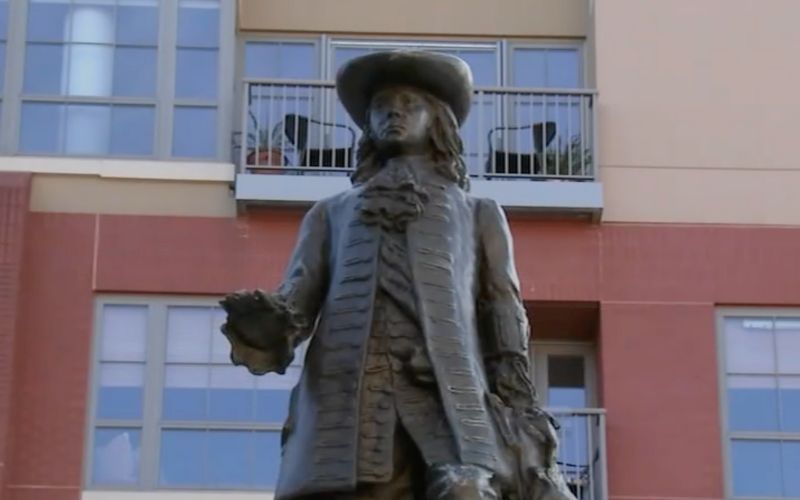
- Details
- By Native News Online Staff
Removing the statue was proposed in the National Parks Service’s (NPD) renovation of the plaza, scheduled to be completed by 2026 for the 250th anniversary of the signing of the Declaration of Independence.
In accordance with the National Historic Preservation Act, NPS consulted with representatives of the Haudenosaunee, the Delaware Nation, the Delaware Tribe of Indians, the Shawnee Tribe, and the Eastern Shawnee Tribe of Oklahoma, whose ancestors were displaced by the Pennsylvania colony.
Penn arrived in present-day Philadelphia in 1682 after being granted the charter for a huge swath of land by King Charles II, land that the English had wrested from Dutch colonialists.
Jeremy Johnson, director of cultural education for the Delaware Tribe of Indians, told NBC Philadelphia that removing the state wasn’t a major point of discussion when NPS officials and tribal representatives met to plan the renovation over video last year. Instead, tribal representatives envisioned an exhibit in the park highlighting the culture, history, traditions and perceptions of the Native Americans who had lived there for thousands of years before Penn arrived.
“We do still speak highly of William Penn,” Johnson said. But tribal representatives “were really just focusing on our culture and our history and that, in a way, he was an important part of it, but ... it was a small interaction compared to our overall history.”
That plan would replace a timeline of Penn’s life and legacy on one wall — with such titles as “gentleman,” “Quaker,” “proprietor” and “friend of Indians” — with new panels featuring indigenous history. The plan also involved adding native plants and trees and circular benches to make it more welcoming, Johnson said.
Ben Barnes, chief of the Shawnee Tribe, told NBC Philadelphia that he objects to removing the statue and pointed out that of the colonists of the time, Penn was known as an ally to Native Americans.
“William Penn was an ally of the Shawnee,” Barnes said. “As long as he lived, he kept his promise. As long as he was able to speak on behalf of the colony in western Pennsylvania, the Shawnees had a home there ... Of all the terrible human beings that inflicted tragedy upon Native peoples, I don’t put William Penn in that category.”
NBC Philidelphia reports that historians say Penn’s willingness to negotiate with Native Americans distinguished him from previous colonizers in the Chesapeake and New England, where early colonial regimes were more willing to use armed force in bloody confrontations to expand their settlements. However, Penn’s mission still led to the dispossession of natives, historians say.
Last week, NPS withdrew the proposal to remove the statue of Penn after public blowback.
More Stories Like This
Native News Weekly (August 25, 2024): D.C. BriefsUS Presidents in Their Own Words Concerning American Indians
Indigenous Actor Elaine Miles Reports Detention by Alleged ICE Agents
Happy Thanksgiving from Native News Online
Coming Up on Native Bidaské: Behind the Animation: Joey Clift Talks “Pow” and Native Storytelling
Help us tell the stories that could save Native languages and food traditions
At a critical moment for Indian Country, Native News Online is embarking on our most ambitious reporting project yet: "Cultivating Culture," a three-year investigation into two forces shaping Native community survival—food sovereignty and language revitalization.
The devastating impact of COVID-19 accelerated the loss of Native elders and with them, irreplaceable cultural knowledge. Yet across tribal communities, innovative leaders are fighting back, reclaiming traditional food systems and breathing new life into Native languages. These aren't just cultural preservation efforts—they're powerful pathways to community health, healing, and resilience.
Our dedicated reporting team will spend three years documenting these stories through on-the-ground reporting in 18 tribal communities, producing over 200 in-depth stories, 18 podcast episodes, and multimedia content that amplifies Indigenous voices. We'll show policymakers, funders, and allies how cultural restoration directly impacts physical and mental wellness while celebrating successful models of sovereignty and self-determination.
This isn't corporate media parachuting into Indian Country for a quick story. This is sustained, relationship-based journalism by Native reporters who understand these communities. It's "Warrior Journalism"—fearless reporting that serves the 5.5 million readers who depend on us for news that mainstream media often ignores.
We need your help right now. While we've secured partial funding, we're still $450,000 short of our three-year budget. Our immediate goal is $25,000 this month to keep this critical work moving forward—funding reporter salaries, travel to remote communities, photography, and the deep reporting these stories deserve.
Every dollar directly supports Indigenous journalists telling Indigenous stories. Whether it's $5 or $50, your contribution ensures these vital narratives of resilience, innovation, and hope don't disappear into silence.
 The stakes couldn't be higher. Native languages are being lost at an alarming rate. Food insecurity plagues many tribal communities. But solutions are emerging, and these stories need to be told.
The stakes couldn't be higher. Native languages are being lost at an alarming rate. Food insecurity plagues many tribal communities. But solutions are emerging, and these stories need to be told.
Support independent Native journalism. Fund the stories that matter.
Levi Rickert (Potawatomi), Editor & Publisher

